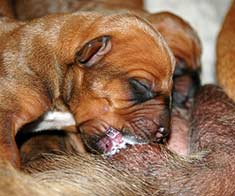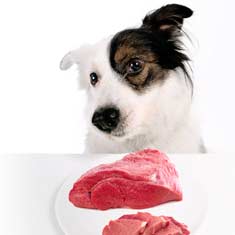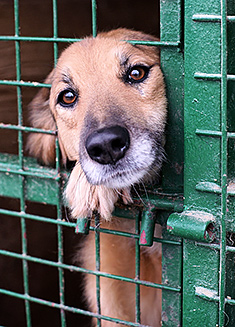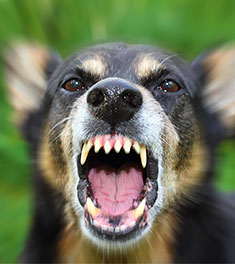Socializing Your Dog
No, socializing doesn’t mean teaching your dog which fork to use at dinner parties or how to walk with a book on his head. Dog socialization involves teaching your dog to respond in a healthy way to things that make him anxious or frightened.
Why is socialization important?
A well-socialized dog is much better able to deal with the stresses of everyday life in ways that are not harmful or destructive. For example, if two dogs meet through a fence, the well-socialized dog will be capable of striking up a relationship with the other dog, sniffing him or wagging his tail to show his pleasure at meeting a new friend. The dog who is not well-socialized may become aggressive, causing the fur on his back to stand on end and growling, or he may become nervous, running up and down the fence line barking or trying to outrun his chain. Indoors, a dog who becomes nervous every time the doorbell rings may urinate on the carpets or bite strangers who enter your home.
In addition to being a miserable way for the dog to live, these behaviors can make your life very unpleasant as well. Although socialization takes time and patience, it is an investment that pays huge dividends over the life of the dog.
When should I socialize my dog?
Although many people think of socialization in terms of something that needs to be done with puppies, dogs never outgrow their need for socialization. However, there are times when it is more important than at other times. Like babies, dogs have a period during their puppyhood when they are most in need of learning to trust their environments. For puppies, this period is from 3 to 12 weeks. During this time, it is vital that your puppy be exposed to many different people, situations, sounds, and feelings.
During these periods of exposure, the puppy must be near a person he trusts so he can learn that the world is not entirely a scary place. If the puppy can spend a little bit of time experiencing the world, then be able to come back to a place of comfort such as by your side, he will learn that it’s okay to hear loud noises or meet new people without losing the comfort he craves.
Your dog may also need socialization before any major changes to his life. For example, if a new baby is being brought into the household, it is a good idea to let your dog get used to the idea before the baby actually comes home. Or, if you are moving to a new home, you might want to allow your dog to spend a few hours each day there before moving day so he doesn’t fall apart on you while you are dealing with your own stresses of moving.
How do I socialize my dog?
One of the most important things you can do for your dog is to take him to puppy socialization classes when he is very young, usually between four and six months of age. These puppy classes allow your dog to learn to be around other dogs and their people in a non-threatening environment. He will not learn any obedience skills in these classes, but he will learn how to interact with other people and other dogs in a positive way.
The next step is an obedience class at about 6 months of age. During this class, the dog will learn the importance of following your commands. This is important from the standpoint that you can then use these commands to guide your dog when he encounters future situations that require further socialization. For example, if you have taught your dog to come when you call, and later he meets a child who pulls his tail, you can call your dog to you before he bites the child. A dog who is well-trained in obedience commands will be much safer as he grows, as well as much easier to control when he becomes nervous or frightened.
Finally, as mentioned above, whenever there will be a major change in the dog’s life, you should carefully prepare him for the experience. A couple of specific strategies for different situations will be discussed in more detail below.
How do I socialize my dog so he won’t jump on people?
This is a common problem among dogs, and it seems that larger dogs are more prone to jump than smaller dogs. Maybe it’s just less annoying when small dogs jump, but either way, it is best for dogs to keep all four paws on the ground. For those of you with giant dogs, this is especially important from a safety standpoint. The best way to teach a dog not to jump is to make sure that he is never, ever, rewarded for jumping on a person. Do not let your friends pat their chests to encourage the dog to jump on them. The dog does not know the difference between jumping on your 6’5” nephew and jumping on your frail great-grandmother, where he can do some real harm.
Using a very short lead, introduce your dog to people you have invited to your home. Using the short lead gives your dog absolutely no opportunity to jump, which means he cannot fail the test. Coach your visitors before they come over that they are not to give the dog any attention until he sits in front of them. Lead the dog to the visitor and tell him to sit. As soon as he does, both you and the visitor should praise him as if he were a toddler who peed in the potty the first time!
Repeat this with as many visitors as you can, each time giving the dog attention and even treats for sitting down to meet a new person. As the dog becomes able to do this without the sit command, begin giving him a longer leash and continue repeating the exercise until he can do it without any leash or command at all.
If the dog doesn’t get the message with these positive training tips, you can try a negative consequence. Most dogs respond much better to positive training, but sometimes a negative consequence may be needed, although it usually won’t be needed more than once or twice. For this particular problem, the best consequence is a knee to the chest of the dog while he has his paws on your shoulders. The contact shouldn’t be enough to cause the dog to whimper in pain, but just enough to make your point. This is the only attention the dog should be given when he is jumping. And once all four of his paws hit the ground again, the praise should begin.
How do I introduce my dog to the new baby?
One of the biggest problems that happens when you bring home a new baby is that the dog no longer holds the center of the attention in your home. You can prepare your dog for this change while you are pregnant. Set aside a special time each day when you spend time with only the dog. This time should be sacred to you; don’t ever miss it. At other times during the day, you will pay slightly less attention to the dog. Every day, the amount of time you spend ignoring the dog should increase by a bit, but during your reserved time, you must give him your full attention.
Spend some time holding a doll while sitting on the floor or a couch where your permit your dog to join you. Allow the dog to get as close to the doll as you would be comfortable with him approaching the real baby. If you will allow the dog to sniff the baby, allow him to sniff the dog. If you will insist that the dog stay at arms’ length from the baby, then keep him at arms’ length from the doll. When he does the right thing, praise him and give him treats. When he does the wrong thing, give him a command to sit, stay or go to his bed, whichever is appropriate. Again, this is where early obedience training pays off.
After the baby is born, have daddy bring home a blanket or a T-shirt with the baby’s scent on it. Allow the dog to smell the item, but do not allow him to chew on it. Daddy may want to spend some time cradling the scented item, as you have been doing with the doll, so the dog realizes this is just another incidence of couch time when he must be patient in order to have his individual play time later in the day.
Once you bring the baby home, most dogs will be absolutely fine with him or her. However, a small child should never, ever be left alone with any dog, regardless of whether or not the dog has ever been aggressive. Even the most placid of dogs has been known to become testy when they don’t feel well or when they have had enough of getting their tails pulled. It’s just not worth the risk to your child.
What about other situations?
As you can see from the above examples, socializing your dog to any situation requires time, patience, and a bit of ingenuity. Slowly introduce your dog to new things that may frighten him and reinforce him positively with attention and treats when he behaves in a positive manner or when he follows your commands. Don’t punish the dog for not being able to respond well to a situation you have not anticipated, but use the circumstances as a teachable moment and show him how you expect him to act. Use mostly positive teaching tactics, but you may have to throw in a negative consequence if he is resisting the positive training or if the situation has to be stopped immediately due to safety implications.
Doggies Den: Latest Articles
 Homemade Thanksgiving Treats for Your Dog
Homemade Thanksgiving Treats for Your Dog
NUTRITION We all want to include our dogs in our holiday celebrations, but hopefully, you're aware that sharing table scraps with your dog isn't always the best idea.
 Keeping Your Dog Safe during the Summer Months
Keeping Your Dog Safe during the Summer Months
HEALTH Summer is coming on fast, so it’s time to plan how you will keep your dog safe and healthy through the lazy, carefree, warm days.
 Vaccination Time Again-Keeping Your Puppy Healthy
Vaccination Time Again-Keeping Your Puppy Healthy
DOG HEALTH So you have your new puppy picked out. There are quite a few shots, treatments and examinations that will keep the newest member of your family healthy.
 Canine Thanksgiving Feast
Canine Thanksgiving Feast
NUTRITION With the wide variety of food at Thanksgiving dinner, chances are you'll want to give your dog something special, too. If you're contemplating what to feed your dog for the holiday, here is a guide to a great Canine Thanksgiving Feast.
 Dog Walking Tips Every Owner Should Know
Dog Walking Tips Every Owner Should Know
DOG FUN Walking your dog is not only crucial to keeping him healthy and happy, it strengthens the bond between your canine friend and his caregiver. There are a lot of obstacles out there. Don’t forget these simple tips to keep your walk fun and safe in the outside world.
 The Benefits of Physiotherapy for your Dog
The Benefits of Physiotherapy for your Dog
HEALTH The same techniques that physiotherapists use to treat a variety of injuries and conditions in humans have been adapted to suit animals with great success. Family pets, show dogs, and working dogs can all benefit greatly from physiotherapy. Dogs whose activities involve a lot of agility are especially susceptible to the types of problems that physiotherapy can address.
 The Decision- Adding a Dog to Your Family
The Decision- Adding a Dog to Your Family
FIRST TIME OWNERSBringing a dog into your family is a decision where many people don’t realize it’s magnitude until after they have the dog. There are a number of things that you need to research before you decide to purchase a dog, and it starts right in your own home.
 Bringing Your Dog Into Your New Baby's Life
Bringing Your Dog Into Your New Baby's Life
HEALTH Many believe that a dog and a new baby cannot happily coexist, so therefore the dog has to go. This is not necessarily the case.  A new baby does not mean you have to abandon your dog.

Doggies Den:
Most Popular Articles

Dog Pregnancy Symptoms
HEALTHIf you suspect your dog might be pregnant, check out part one in this series on pregnant dogs, where we cover pregnant dog symptoms.

Dog Birth
HEALTHIn the third article of our dog pregnancy series, we look at the wonderful, but messy, process of bringing newborn puppies into the world.

Indoor Dog Potties
DOG PRODUCTSIt's been a long day at work. You were so busy, you didn't even take time to eat a sandwich, let alone run home to let your dog out. You're on your way home, knowing the poor dog is crossing his or her legs by now, when your car breaks down, delaying you even further. Can't somebody make this easier?

Your Dog’s Digestive System
PHYSIOLOGYEver wonder why your dog eats so fast? Or why he eats gross things? Or why he gets sick to his stomach? Or why his waste stinks so bad? Some of these things are normal, some are not.

Canine Respiratory System
BREATHINGThe basic function of your dog's respiratory system is to bring oxygen in to and remove carbon dioxide from the body. Knowing the symptoms of respiratory diseases can help you help your stay healthy.

Shelter Dog Adoption Tips for Success
ADOPTION Are you intimidated by the prospect of "rescuing" a dog from a shelter? One reason that you may be wary of adopting a dog from a shelter is not knowing how to choose. Adopting a dog from a shelter can be a rewarding process, if you're prepared to do a reasonable amount of research.

Canine Urinary Tract Infections
SYMPTOMS AND TREATMENTDoes your dog seem to be having trouble relieving his or her bladder? Learn how to recognize the signs of urinary tract infections and how to treat them before they spread.

What to do for Dog Diarrhea
SYMPTOMS AND REMEDIESIf you have dogs in your house for any length of time, you have likely experienced at least one bout of dog diarrhea. Beyond the pain in the tuckus involved in cleaning up the mess, you should know what causes diarrhea, and when it's important to see the vet.

What to do for a Dog Bite
DOG BEHAVIOR Getting bitten by a dog can be scary, and you may be tempted to run around in circles for a while, trying to figure out what to do. Here's our guide to help you manage the situation.

Top Ten Tips for Living with a Senior Dog
DOG HEALTH Bringing home a new puppy is so exciting, but it doesn’t take all that long for your exuberant puppy to grow into a senior dog who may have special needs. Here are the doggies.com top ten tips for taking care of your companion who has been with you through so much.
